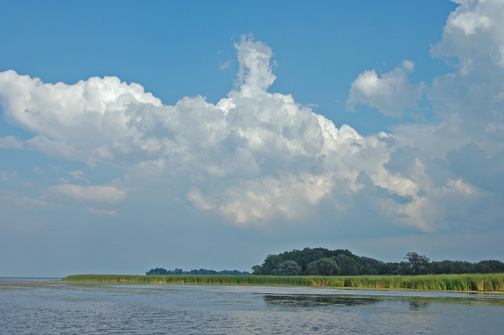Priorities: contaminated sewer overflow...invasive species...toxic contaminants in sediments ... protection of drinking water... economic impact of tourism, fisheries, wildlife and other industries relying on Great Lakes
A Congressional Legislative Hearing before the Committee on Environment and Public Works was held July 16, 2014. To track these bills: Library of Congress bill tracking website.
• The Great Lakes Water Protection Act, S. 571, addresses sewer overflows. The measure, authored by Sen. Mark Kirk, R-Ill., would ban the sewer overflows that pour contaminated water into the lakes. After 2033, counties, cities and other political entities
 |
| West Spit Braddock Bay NY |
• The Invasive Fish and Wildlife Prevention Act, S. 1153, would speed up the federal government's review process when it considers whether to ban the importation of animals and plants. Current screening takes more than four years to complete. In the Illinois River, where Asian carp infestation is extreme, 90 percent of the river’s biomass is now Asian carpThe measure is authored by Sen. Kirsten Gillibrand, D-N.Y. The House version of the legislation, H.R. 996, lists U.S. Rep. Marcy Kaptur, D-Toledo, as a co-sponsor. For more: NY Invasive Species.
• The Great Lakes Ecological and Economic Protection Act, S. 1232. The measure, authored by Sen. Carl Levin, D-Mich., and co-sponsored by Sen. Sherrod Brown, D-Ohio, would reauthorize the Great Lakes Restoration Initiative, an Obama administration program which has provided $300 million a year for the last four years for programs to clean up the lakes. It would also reauthorize the Great Lakes National Program Office, the main Environmental Protection Agency office for Great Lakes matters, and the Great Lakes Legacy Program, which removes contaminated sediment from polluted areas. The bill also would authorize the Federal Great Lakes Interagency Task Force, which pulls together different federal agencies to help the Great Lakes. To see where the money goes in the Rochester NY area: Great Lakes Restoration Initiative projects at Braddock Bay, area beaches and wetlands.
Among those testifying was Policy Director of Healing Our Waters the Great Lakes Coalition: testimony is available at the National Parks Conservation Association site. The Great Lakes Coalition was formed in 2004. The Healing Our Waters-Great Lakes Coalition is led by the National Wildlife Federation and the National Parks Conservation Association. The Coalition has staff in Washington, D.C., Ann Arbor, Michigan, Madison, Wisconsin, and Chicago, Illinois. From the Sandusky, Ohio Register, July 18, 2014.
